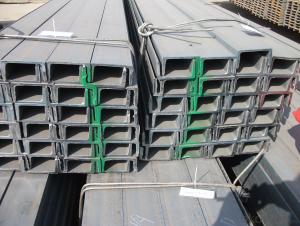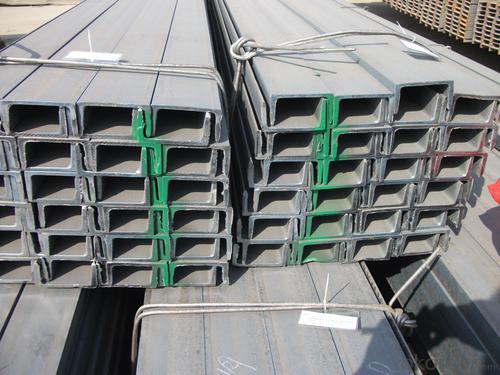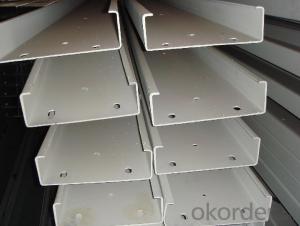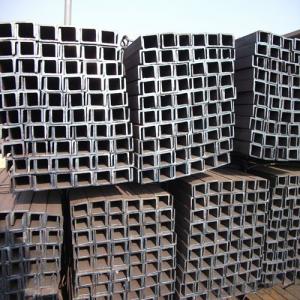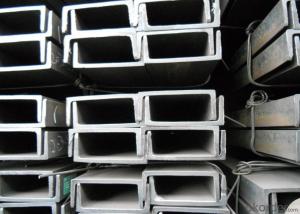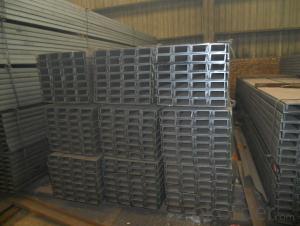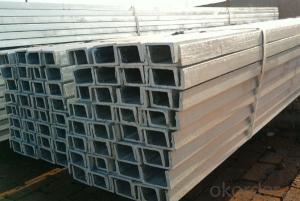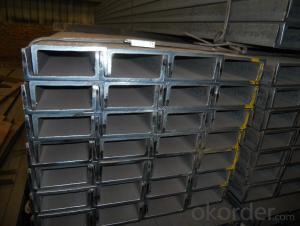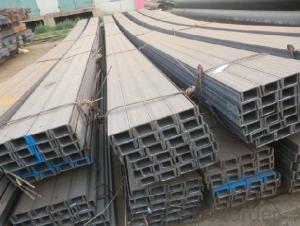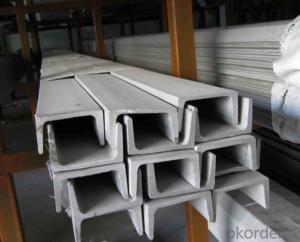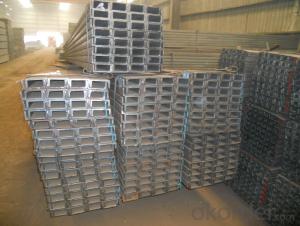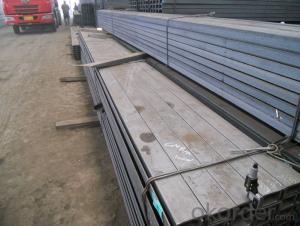JIS Standard Hot Rolled Steel U-channel with High Quality
- Loading Port:
- China Main Port
- Payment Terms:
- TT or LC
- Min Order Qty:
- -
- Supply Capability:
- -
OKorder Service Pledge
OKorder Financial Service
You Might Also Like
Product Description:
OKorder is offering STEEL CHANNEL at great prices with worldwide shipping. Our supplier is a world-class manufacturer of steel, with our products utilized the world over. OKorder annually supplies products to European, North American and Asian markets. We provide quotations within 24 hours of receiving an inquiry and guarantee competitive prices.
Product Applications:
The steel u channel can be applied to construction of warehouses, workshops, sport stadiums and car parks etc. In details, the steel u channel belongs to carbon structural steel which is applied to in the field of construction and machinery. The steel u channel is usually used for arch-itechtural structure, and they could be welded in order to support or hang a vari-ety of facilities. They are also usually used in combination with I beam. Generally,the steel u channel must possess perfect welding property, riveting property and mechanical property and so on.
Product Advantages:
OKorder's STEEL CHANNELare durable, strong, and resist corrosion.
Main Product Features:
· Premium quality
· Prompt delivery & seaworthy packing (30 days after receiving deposit)
· Corrosion resistance
· Can be recycled and reused
· Mill test certification
· Professional Service
· Competitive pricing
Product Specifications:
Minimum Order Quantity: 25 Tons Unit: m.t. Loading Port: Xingang Port
Supply Ability: 1000 Tons Per Day Payment Terms: TT or L/C
Product Description:
Specifications of Steel U Channel:
Standard Applied: GB Standard, EN Standard(UPN), JIS Standard
Sizes: 50mm to 300mm
Material Grade: Q235B, Q345B, S235JR, SS400, ASTM A36
Usage/Application of Steel U Channel:
The steel u channel can be applied to construction of warehouses, workshops, sport stadiums and car parks etc. In details, the steel u channel belongs to carbon structural steel which is applied to in the field of construction and machinery. The steel u channel is usually used for arch-itechtural structure, and they could be welded in order to support or hang a vari-ety of facilities. They are also usually used in combination with I beam. Generally,the steel u channel must possess perfect welding property, riveting property and mechanical property and so on.
Package & Delivery: Steel U Channel
The steel u channel will be packed in bundle with steel wire at each end of every bundle and color marking in order to help the customer to recognize his goods more easily at sight.
And steel u channel could be loaded into 20ft or 40ft container, or by bulk cargo. If the weight of each bundle reaches less than 3.5 mt, the loading by break bulk cargo should be choosed. When the weight of each bundle reaches less than 3mt, the loading by container should be choosed.
As for the transportaion from mill to loading port, the truck will be usually used. And the maximum quantity for each truck is 40mt.
All in all, we could do in accordance with customer's request
FAQ:
Q1: Why buy Materials & Equipment from OKorder.com?
A1: All products offered byOKorder.com are carefully selected from China's most reliable manufacturing enterprises. Through its ISO certifications, OKorder.com adheres to the highest standards and a commitment to supply chain safety and customer satisfaction.
Q2: How do we guarantee the quality of our products?
A2: We have established an advanced quality management system which conducts strict quality tests at every step, from raw materials to the final product. At the same time, we provide extensive follow-up service assurances as required.
Q3: What makes stainless steel stainless?
A3: Stainless steel must contain at least 10.5 % chromium. It is this element that reacts with the oxygen in the air to form a complex chrome-oxide surface layer that is invisible but strong enough to prevent further oxygen from "staining" (rusting) the surface. Higher levels of chromium and the addition of other alloying elements such as nickel and molybdenum enhance this surface layer and improve the corrosion resistance of the stainless material.
JIS CHANNEL | Standard h | Sectional b | Dimension s | t | Mass: Kg/m |
| (mm) | (mm) | (mm) | (mm) |
|
50x25 | 50 | 25 | 3.0 | 6.00 | 2.37 |
75X40 | 75 | 40 | 3.8 | 7.00 | 5.30 |
75X40 | 75 | 40 | 4.0 | 7.00 | 5.60 |
75X40 | 75 | 40 | 4.5 | 7.00 | 5.85 |
75X40 | 75 | 40 | 5.0 | 7.00 | 6.92 |
|
|
|
|
|
|
100X50 | 100 | 50 | 3.8 | 6.00 | 7.30 |
100X50 | 100 | 50 | 4.2 | 6.00 | 8.03 |
100X50 | 100 | 50 | 4.5 | 7.50 | 8.97 |
100X50 | 100 | 50 | 5.0 | 7.50 | 9.36 |
|
|
|
|
|
|
125X65 | 125 | 65 | 5.2 | 6.80 | 11.66 |
125X65 | 125 | 65 | 5.3 | 6.80 | 12.17 |
125X65 | 125 | 65 | 5.5 | 8.00 | 12.91 |
125X65 | 125 | 65 | 6.0 | 8.00 | 13.40 |
|
|
|
|
|
|
150x75 | 150 | 75 | 5.5 | 7.30 | 14.66 |
150x75 | 150 | 75 | 5.7 | 10.00 | 16.71 |
150x75 | 150 | 75 | 6.0 | 10.00 | 17.90 |
150x75 | 150 | 75 | 6.5 | 10.00 | 18.60 |
150x75 | 150 | 75 | 6.5 | 10.00 | 24.00 |
|
|
|
|
|
|
200X80 | 200 | 80 | 7.5 | 11.00 | 24.60 |
Images:
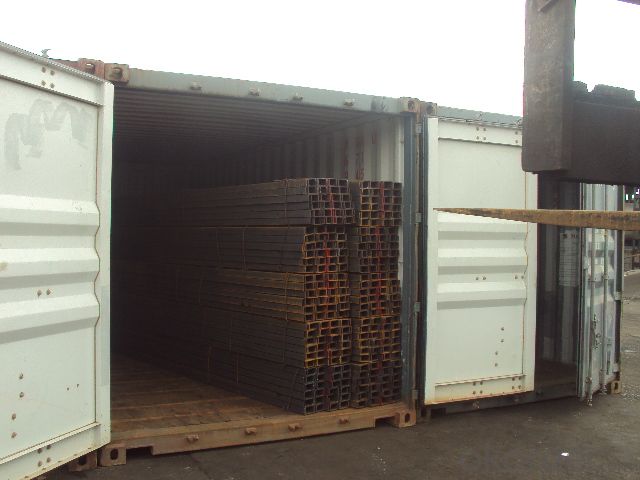
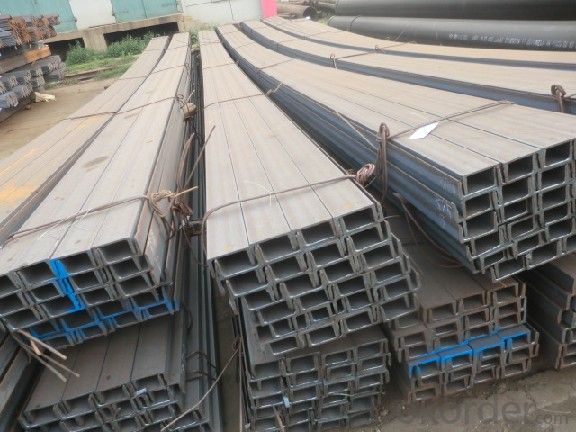
- Q: Can steel channels be used in data center construction?
- Yes, steel channels can be used in data center construction. Steel channels are commonly used in construction for their strength, durability, and versatility. In data center construction, steel channels can be used for various purposes such as framing and support structures for raised floors, server racks, cable trays, and equipment mounts. They provide a strong and stable framework that can withstand heavy loads and ensure the structural integrity of the data center. Additionally, steel channels can also be used for cable management, allowing for organized routing and protection of data and power cables throughout the facility. Overall, steel channels are a reliable and widely used component in data center construction due to their structural properties and suitability for supporting the complex infrastructure requirements of modern data centers.
- Q: Can steel channels be used for partition walls?
- Indeed, partition walls can indeed be constructed using steel channels. In the realm of construction, steel channels are widely favored due to their robustness and resilience. They furnish a solid framework for partition walls and adeptly bear the load of wall finishes, be it drywall or plasterboard. It is worth noting that steel channels offer the added benefit of being fire-resistant, thereby bolstering the partition wall's structural soundness. Moreover, the employment of steel channels affords ample room for creativity and personalization in design, rendering them fitting for a plethora of applications in both residential and commercial ventures.
- Q: Can steel channels be used for electrical installations?
- No, steel channels cannot be used for electrical installations as they are conductive and can pose a safety hazard. Electrical installations require non-conductive materials such as PVC or aluminum channels to ensure proper insulation and prevent the risk of electric shock.
- Q: Can steel channels be used in infrastructure projects?
- Infrastructure projects can utilize steel channels effectively. These channels are commonly employed in construction and infrastructure projects as they serve as a versatile and widely used structural component. Their primary purpose is to provide support and stability to structures like bridges, buildings, and highways. The use of steel channels in infrastructure projects offers several advantages. Firstly, they possess exceptional strength and durability, enabling them to withstand heavy loads and harsh weather conditions. This ensures the long-term integrity and stability of the infrastructure. Moreover, steel channels can be easily fabricated and tailored to meet specific project requirements. They are available in various sizes, shapes, and thicknesses, allowing engineers and architects to design and construct structures with precision. Furthermore, steel channels exhibit excellent resistance to corrosion. This is particularly important in infrastructure projects that are exposed to moisture or adverse environmental conditions. By galvanizing or applying protective coatings, steel channels can prevent rust and corrosion, thereby prolonging their lifespan. Additionally, steel channels offer cost-efficiency. When compared to other construction materials like concrete or wood, steel channels have a longer lifespan and require less maintenance. As a result, the overall maintenance and replacement costs of infrastructure projects are reduced, making steel channels a cost-effective choice. In conclusion, steel channels are extensively used in infrastructure projects due to their strength, durability, customization options, corrosion resistance, and cost-efficiency. They play a crucial role in providing support and stability to various structures, making them a reliable choice for engineers and architects involved in infrastructure development.
- Q: How much is the channel steel? How much is one and how long is it?. What is the price of different sizes?
- Whether poor channel or national channel, are 6 meters. Channel twelve meters, unless you are specially made to order. With 2, and so on, so long span to do the next floor, GB are not. Unless you are about 3 meters, one support. 12 meters long span do general office loft, have to use i-beam. And more than 16#.
- Q: What are the different loadings that steel channels can withstand?
- Steel channels can withstand a wide range of loadings, making them a versatile and reliable structural component. The specific loadings that steel channels can withstand depend on various factors, including the type and grade of steel, the size and shape of the channel, and the design of the overall structure. Steel channels are commonly used in construction and engineering applications to provide support and stability. They can withstand both static and dynamic loadings, which include dead loads, live loads, and environmental loads. Dead loads refer to the weight of the structure itself, including the weight of the steel channels and any other components or materials. Steel channels are designed to bear this constant load without deformation or failure. Live loads are temporary loads that can vary in magnitude and location. These loads include the weight of people, furniture, equipment, and other transient forces. Steel channels are designed to support these loads and distribute them effectively to other structural members. Environmental loads include wind loads, snow loads, and seismic loads. Steel channels are designed to resist these external forces and maintain the structural integrity of the building or structure. Wind loads can exert significant pressure on the channels, especially on tall or exposed structures. Snow loads can accumulate and add weight to the structure, which the steel channels must be able to support. Seismic loads refer to the forces generated during an earthquake, and steel channels are designed to withstand these dynamic loads and prevent the structure from collapsing. In addition to these common loadings, steel channels can also withstand other specialized loadings, such as impact loads, vibration loads, and thermal loads. Impact loads can occur due to accidental collisions or sudden impact events and require steel channels to have high strength and toughness. Vibration loads can result from machinery or equipment operation and require steel channels to have good fatigue resistance. Thermal loads can cause expansion and contraction of the steel channels due to temperature changes, and they must be designed accordingly to prevent failure. Overall, steel channels have a high load-bearing capacity and can withstand a wide range of loadings, making them suitable for various structural applications in construction, engineering, and industrial sectors.
- Q: Can steel channels be used in food processing facilities?
- No, steel channels should not be used in food processing facilities as they can rust and contaminate the food. Stainless steel channels should be used instead, as they are corrosion-resistant and meet the hygiene requirements of such facilities.
- Q: Can steel channels be used for aesthetic purposes in architectural designs?
- Yes, steel channels can certainly be used for aesthetic purposes in architectural designs. Steel channels are versatile structural elements that can be used in various architectural applications, including both functional and decorative purposes. In terms of aesthetics, steel channels offer a sleek and modern appearance that can enhance the overall visual appeal of a building or structure. They can be used to create distinctive and eye-catching designs, as their unique shapes and profiles can add a sense of depth and dimension to architectural elements. Steel channels can be incorporated into architectural designs in a variety of ways. They can be used as exposed structural elements, such as in the construction of bridges or walkways, where their clean lines and geometric shapes can create a visually striking effect. Additionally, steel channels can be used as decorative features, such as in the design of staircases or railings, where their sleek and contemporary look can add a touch of elegance and sophistication to the space. Furthermore, steel channels can be finished in a wide range of colors and textures, allowing for customization to match the desired aesthetic theme of a project. They can be painted, powder-coated, or even left in their natural steel finish, depending on the desired visual effect. Moreover, steel channels offer durability and strength, making them suitable for a wide range of architectural applications. They are resistant to corrosion and weathering, ensuring their longevity and low maintenance requirements. In conclusion, steel channels can definitely be used for aesthetic purposes in architectural designs. Their versatility, sleek appearance, and durability make them a popular choice for architects and designers looking to create visually appealing and contemporary structures. Whether used as exposed structural elements or decorative features, steel channels can add a touch of sophistication and modernity to any architectural design.
- Q: What are the cost considerations of using steel channels?
- There are several cost considerations to take into account when using steel channels. Firstly, the cost of the steel material itself is a major factor. The price of steel can fluctuate depending on market conditions and availability, so it is important to consider these variables when estimating the overall cost. Another cost consideration is the fabrication process. Steel channels often require cutting, welding, and shaping to meet specific project requirements. The cost of these fabrication processes, including labor, equipment, and materials, should be factored into the overall project budget. Transportation and shipping costs can also add to the total cost of using steel channels. Steel is a heavy and bulky material, so transporting it from the manufacturing facility to the construction site can be expensive, especially if long distances are involved. Furthermore, the installation process should be considered when evaluating the cost of using steel channels. Depending on the complexity of the project, specialized equipment or expertise may be required for proper installation. These additional costs should be considered when estimating the overall project budget. Lastly, it is important to consider the long-term costs associated with steel channels. Steel is known for its durability and longevity, which can result in lower maintenance and replacement costs over time. However, factors such as corrosion protection and regular inspections should be considered to ensure the longevity of steel channels and avoid unexpected expenses in the future. In conclusion, the cost considerations of using steel channels include the cost of the steel material, fabrication processes, transportation and shipping, installation, and long-term maintenance. By carefully considering these factors and conducting a thorough cost analysis, one can make informed decisions regarding the use of steel channels in construction projects.
- Q: What is the concept of nonstandard channel steel compared with the national standard channel steel? Is there any difference in size between the national standard channel steel and the material?
- Non-standard channel steel, with channel steel waist height, leg width, waist thickness and per meter weight as the standard, non-standard channel steel, mainly in order to not affect the safety quality of the premise of cost saving, in high, wide and thick discount. For example, 12# channel weight per meter 6 meters for 12.059kg, 72.354kg, and 12# 6 if a channel is 48kg, then we call it under 33.3% (1-48/72.354). In our country, most of the steel market has sales of non-standard profiles, this is called "cut foot".
Send your message to us
JIS Standard Hot Rolled Steel U-channel with High Quality
- Loading Port:
- China Main Port
- Payment Terms:
- TT or LC
- Min Order Qty:
- -
- Supply Capability:
- -
OKorder Service Pledge
OKorder Financial Service
Similar products
Hot products
Hot Searches
Related keywords
